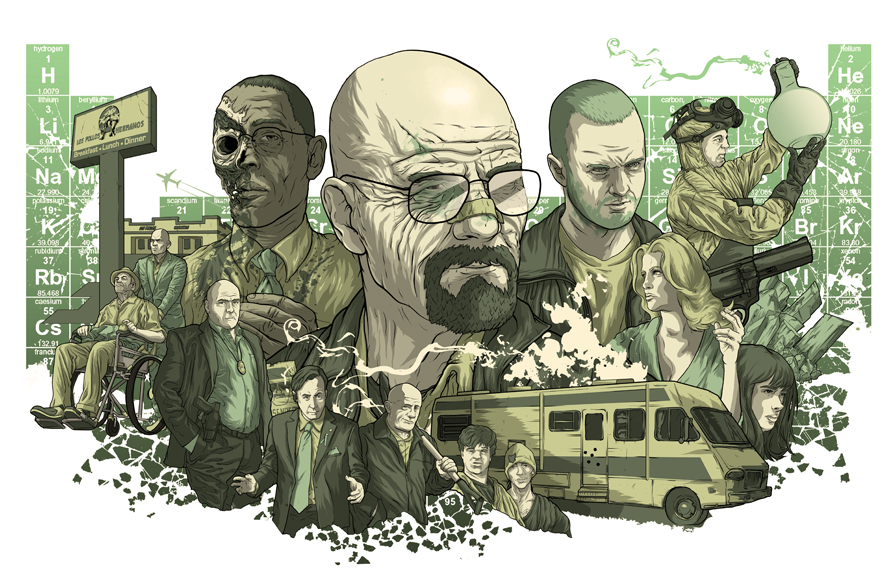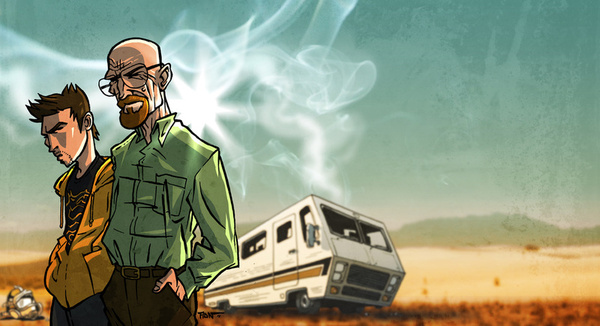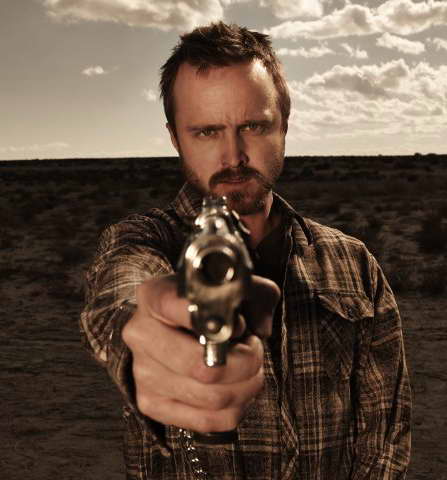So for those of you on my newsletter, you know I posed the question last week of, which article did you want me to write?: Why Breaking Bad is so good, or why The Fast and the Furious franchise is so successful. Now a lot of you may think this is a no-brainer. Breaking Bad is one of the best written shows in television history. The Fast and The Furious is eye-candy, fast cars and hot women. But here’s why it was a close vote. Readers pointed out that they knew why Breaking Bad was so good. It wore its great writing on its sleeve. What they couldn’t figure out was how this seemingly vapid car franchise was one of the biggest franchises in history with no hints of slowing down. That needed explaining. And what intrigued ME about it was The Fast and the Furious franchise started as a spec! That means it’s the only spec-driven franchise in decades that was able to hang with the likes of IP properties Batman, Harry Potter, Lord of the Rings, etc. To think that one of you guys could learn from that and start your own franchise based on a spec – I thought that was worth exploring.
So then why am I going with Breaking Bad instead of Furious? For the simple reason that I haven’t figured out what makes The Fast and The Furious so successful from a screenwriting point of view. From a concept point of view and from a casting point of view, I know. But I’m going to have to delve back into the franchise’s scripts to see why it stands out from other similar movies (like Driven and Gone in Sixty Seconds). Breaking Bad, on the other hand, oozes good writing in just about every episode, which is really hard to do (to give you some perspective, I’ve been going back over Lost and found some real dud eps – there’s an episode where Sawyer chases a boar. That’s the whole episode!). So I thought, why not show everyone how to do it right?
For those of you who don’t know anything about Breaking Bad, it’s about a high school teacher, Walter White, who finds out he’s dying of cancer. Walter has a special needs son and a pregnant wife and if he were to die today, they’d have zip to live off of. So Walter needs to make a lot of money really fast before he dies. Being a chemistry professor, he realizes that making meth offers the biggest buck for its bang. All he needs is someone to sell it. Enter his former flunky student and current small-time dope dealer, Jesse. The two are the most unlikely pair, but when Jesse realizes how much money Walter (or “Mr. White” as he knows him) can make him, he jumps on board. Of course, since the two have no idea how the upper-level drug trade works, their world gets really crazy really fast.
Breaking Bad works for a ton reasons. First, Walter is leading a double life. He must be the upstanding family man in one world, and the relentless drug producer in another. Remember that double-lives lead to one of the most powerful storytelling devices there is: dramatic irony. We know Walter is secretly a drug dealer, but his wife and family and friends do not. This means in most of the scenes, he’s hiding something, and when one character is hiding something from another, the scene is always watchable. Will he get caught? Is someone on to him? What happens if they catch him? We have to know! It’s the same reason why characters like Superman and Batman and Spider-Man have lasted for so long. The double-life thing leads to a lot of easy-to-write scenarios.
Then there are all the little things. Vince Gilligan (the creator) makes Walter’s brother-in-law a D.E.A. agent. Now we don’t just have dramatic irony, we have sky-high stakes. If his brother-in-law finds out he’s making meth? He’s in jail for life! And his brother is always around! We also have the “climbing the drug ladder” aspect of the series. We love watching characters climb up organizations, especially through the drug trade. The baddies keep getting badder and the stakes keep getting higher. It’s why we love Scarface. It’s why we love Goodfellas.
And then the show is funny! When I first heard about Breaking Bad, I mentally tuned it out. A guy dying of cancer? No thanks Depression Channel. But Gilligan makes sure this isn’t a downbeat show. Breaking Bad is packed with humor! In this episode I’m highlighting today, there’s a great scene where Walter and Jesse have a little “teacher-to-student” moment that plays up the silliness of their dynamic (Walter’s trying to teach Jesse about all those things he missed in high school via the battery they’re building. The clueless Jesse proves he hasn’t learned a thing). It’s hilarious. That balance evens out the intensity of the cancer storyline.
And then, of course, there’s the strained Walter-Jesse dynamic, which is the heart of the show. Conflict people. CONFLICT! Not only is this pairing exceptionally ironic (a goody-two-shoes chemistry teacher must go to one of his worst former students for help in the drug trade), but because this is the most unlikely pair in existence, and because they come from two totally different worlds, they’re always at odds with one another, always arguing or debating, and it’s always entertaining. They’re one of the best pairings in TV history.
Which leads us to the episode I’m highlighting today. I knew I couldn’t breaking down ALL of Breaking Bad. It’d be a 20,000 word post. So I looked for an episode that encapsulated what I loved about the show. That episode is “4 Days Out.” It’s the ninth episode of the second season, and Walter’s just learned that he isn’t anywhere near his target money number (the final amount of money he needs so his family can live comfortably after he dies – what I call: The Overall Series Goal).
He’s just received a terrible diagnosis, meaning he may die a lot sooner than he thought. So he calls Jesse and tells him they need to go make a ton of meth RIGHT NOW. The two drive their mobile meth lab (a dying Winnebago) out into the middle of the New Mexico desert, where they won’t be found, and make 1.3 million dollars worth of meth. Time to party right? Yeah. Except Jesse, who’s always doing something moronic, left the keys in the ignition. The battery is dead. The two begin to realize that no one knows where they are (and even if they did, it’s not like Walter can call his wife to pick them up). They’re too far away from anywhere to walk. And there’s no water left. If they don’t figure out a solution soon, they will die out here.
To me, the best television episodes establish a problem or a goal right away. This makes the episode feel self-contained and relevant. Whenever an episode deals with a series of threads and don’t have any form, it tends to feel unfocused and pointless. Every TV show has to do these episodes at some point, and if the threads are interesting enough (or the show is paying off some earlier season mystery), the episode can sometimes overcome this problem. But usually the episodes that stick are the ones that not only work for the show, but work on their own.
“4 Days Out” is not only a master class in how to write a good television episode, it’s a master class in how to write a good movie. Just like in any story, you want to propose a problem. That problem will then lead to a goal. That goal will drive your characters, which will, in turn, drive your episode. In this case, the problem is they’re stuck out in the desert with a dead Winnebago. The goal, then, is to find a way out of the desert to safety.
From there, you provide the stakes. The stakes in this case start off as annoyance, but quickly escalate to death. It’s clear that if they don’t figure out something soon, they’re going to be a permanent part of the horizon. Finally, you have the urgency. With water gone, they’ve got maybe 3 days before they’re dead. This is the basic structure for the episode and it’s practically full-proof. Everything is in place to write something compelling.
That leads us to our next essential ingredient – CONFLICT. If your characters are getting along during this predicament, we’re bored. You, then, need to create friction, create problems and issues between the characters, which will usually revolve around the characters having different points of views on how to solve the problem. Luckily Gilligan establishes at the beginning of the Breaking Bad series that Jesse and Walter really dislike each other. Therefore, it’s only natural that they start bickering like schoolgirls when the battery dies. Goals stakes and urgency set up the party. Conflict IS the party.
Next comes obstacles. Things have to keep getting worse over the course of the story. If the problem stays at the same level, our emotions remain at the same level. You want to play with the audience’s emotions. Obstacles help you do this. So first the generator blows up. Then Jesse puts it out with their remaining water (leaving them with no water to drink). Then the guy who’s supposed to pick them up – Jessie’s druggie friend – gets lost (it’s hard to give directions to the middle of nowhere), Then Walt’s phone goes dead. And their last ditch effort to manually rig the generator fails too. The obstacles have left them with no options left.
This puts the characters at their “lowest point.” We think these two are dead. They think they’re dead. There’s obviously no way out of this. But then our characters (NOT SOME RANDOM DEUS-EX-MACHINA LUCKY BREAK) conceive of a plan (born out of chemistry – so an established part of one of our character’s backgrounds) to build a battery from spare parts. They put away their differences for a moment to work together, and against all odds, somehow make it work! They’ve saved themselves!
Now that’s how to tell a story!
There were a couple of other things I noticed here as well. I love how when Gilligan brings us to a high (they count up all the meth they just made and realize it’s worth 1.3 million dollars) he immediately slams us back down to a low (they find out the battery’s dead). That’s what you want to do with your audience. You should always be bringing them up, then bringing them back down again. I also liked how Gilligan didn’t do the obvious. Writers are inherently lazy people. If we can take the easy way out, we will. It would’ve been really easy here to have it so neither characters’ phone worked. But Gilligan makes it so that Walter’s does, which is more realistic, and forces the writers to work a little harder to keep their characters in harm’s way. It leads to the thread where Jesse calls his stoner friend to come get them. And then of course, later, we find out his friend is lost (once again, bring them up high, then bring them down low). If you take the easy ways out as a writer, your script will read that way. Which is why I loved this choice.
It’s pretty rare that you encounter this level of writing on a consistent basis. I just reviewed the Dracula pilot the other day (the new show on NBC) and it was fine. The goal was a little muddled. The stakes were kind of there. You’re not sure you noticed any urgency. You realize how much better writing can be when you watch Breaking Bad. And revisiting this episode only reinforced that opinion. I had so much fun with, “Four Days Out,” maybe I’ll do another Breaking Bad episode some time. What about you guys? What aspect of Breaking Bad’s writing do YOU enjoy the most. Share. I want to learn too! ☺




